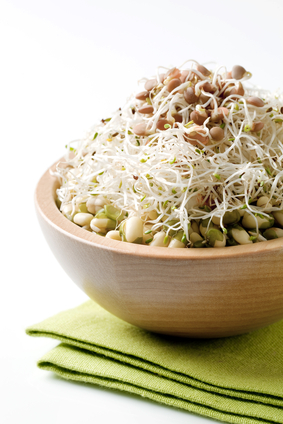 Winter’s long shadows and gray afternoons bring many of us to ‘kitchen gardening’ to meet some of our raw food nutritional needs. This means, among other things, sprouting. There are many advantages, both in health and in economics, to sprouting your own seeds, grains and legumes. Add a Little Spring to Your Winter.
Winter’s long shadows and gray afternoons bring many of us to ‘kitchen gardening’ to meet some of our raw food nutritional needs. This means, among other things, sprouting. There are many advantages, both in health and in economics, to sprouting your own seeds, grains and legumes. Add a Little Spring to Your Winter.
Fresh sprouts are among the must nutritionally dense foods known. Highly alkalizing, sprouts are packed with vitamins, minerals, enzymes, proteins, and concentrated phytonutrients. Alfalfa sprouts, for example, are an ideal source for saponins, which lower ‘bad’ cholesterol as well as fat—but not the ‘good’ HDL fats. Saponins also help stimulate the immune system. Broccoli sprouts contain good amounts of sulforaphane, which helps protect cells from going malignant.
Sprouts can contain 10 to 100 times more of these enzymes than the mature plant. Sunflower sprouts are rich sources of vitamin D and lecithin. Bean sprouts are extremely high in vitamin C. Overall, the benefits of sprouts are undeniable. They’re an easy, delicious way to build more raw food into your diet. You can eat them straight, add to your salad or include in your green smoothies!
Soaking (germinating) seeds, grains and legumes activates plant hormones known as phytosterols. These kick start the seeds’ metabolic activity, making nutrients more bioavailable. The starches are broken down into simple sugars, fats are converted into soluble fatty acids, and the proteins are predigested.
Seeds, grains and legumes also contain enzyme inhibitors. These keep the plant from growing until conditions are right. But consuming enzyme inhibitors can lead to health problems, particularly digestive difficulties, and they can also inhibit the absorption of certain minerals such as calcium, iron and zinc.
Soaking seeds, grains and legumes removes these enzyme inhibitors and the growing process begins.
Sprouts truly are living foods. At the sprout stage, plants contain the necessary elements to develop into a fully mature plant. When you eat sprouts they are still truly alive, as distinct from some market produce, which may have spent days in a boxcar before still more days on the shelf.
Sprouts are, by definition, small. An obvious point, but one with not-so-obvious implications. Due to their size, you can eat hundreds of sprouts at a sitting. Thus a single raw food meal containing sprouts means that you are eating that many young, baby plants. Consider the nutritional implications of that!
Sprouts are extremely economical, as they multiply to as much as 8 to 10 times their weight, and pounds of fresh live greens can be grown for a fraction of what store-bought produce costs. For instance, one tablespoon of alfalfa seeds can yield up to a pound of fresh sprouts—and for just pennies. They’re easy to grow, taking only minutes of your time per day, and you can grow them in any climate or locale. A simple windowsill will suffice. As a bonus, green sprouts add a colorful, cheery touch to dark winter days.
You can get detailed information on sprouts from The Sproutman: Steve Meyerowitz.
You’ll find several effective methods you can use for growing your own sprouts and devices specifically designed for this purpose. But for you low-tech growers, a simple glass canning jar works perfectly well.
The Jar Method…Use an 8- to10-oz. Clean, wide-mouth glass jar. Cut a lid from plastic mesh screen and attach it with a rubber band. Or you can buy special lids for sprouting at your health food store. Rinse the desired amount of clean, organic seeds. Remember that their size doubles when sprouted, so 1/2 cup of seeds will produce at least one cup of sprouts.
After you have rinsed the seeds, place them in the jar. Fill with water and let soak. You’ll find an overnight soaking works fine in most cases. In the morning, drain, rinse the seeds and prop the jar at a 45 degree angle with the opening pointing down to allow for proper drainage and air circulation.
Keep your sprouts out of direct sunlight, rinsing them several times a day. As a rule, sprouts are ready when the tail is the same length as the original seed. When seed sprouts grow leaves, they can be set in the windowsill to develop the chlorophyll in the leaves.
Continue rinsing the sprouts daily as long as you are using them and store in your refrigerator. You’ll want to eat your sprouts as soon as possible—freshness is crucial.
I don’t mention sprouts in my book Quantum Eating. Next edition, perhaps. But I haven’t simply because gardening is impossible for me—I’m on the road ten months a year. Since Quantum Eating is a reflection of my own advanced raw foods journey, I felt that I shouldn’t include foods that I don’t personally use on a daily. However, sprouts are superb foods and are an ideal addition to your Quantum Eating plan. I’m very happy to have sprouts in my diet whenever I can get them.
What if you simply don’t want to garden? No problem…you can achieve the same superb health using mature greens bought at your favorite health food store.
Whether by growing your own, or by getting others to grow for you, by all means do SPROUT! Enjoy your winter harvest as you introduce a little touch of spring.
Related Article:
Raw Food Lifestyle raw foods- Log in to post comments
